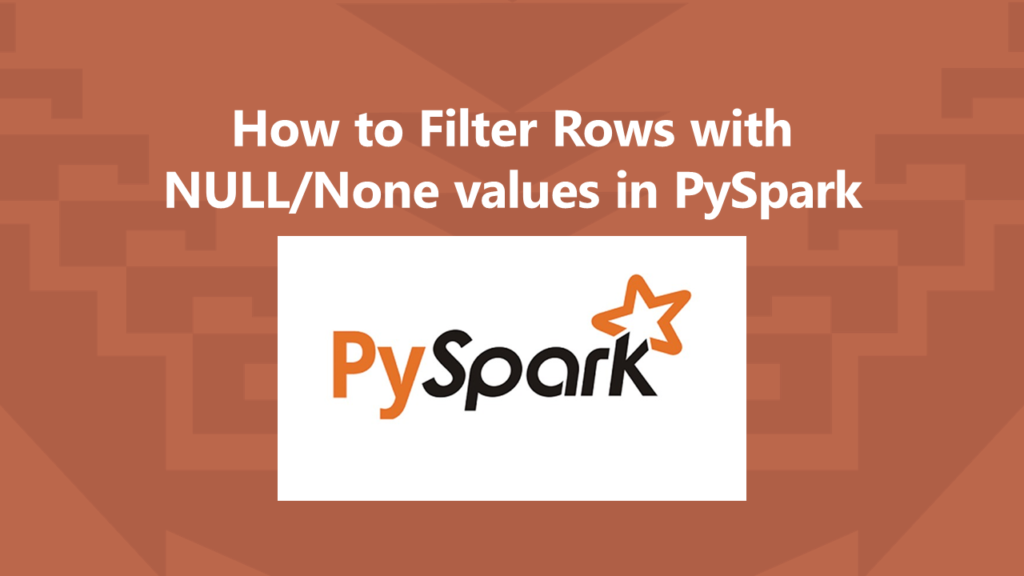While working on PySpark SQL DataFrame we often need to filter rows with NULL/None values on columns, you can do this by checking IS NULL or IS NOT NULL conditions.
In many cases, NULL on columns needs to be handles before you perform any operations on columns as operations on NULL values results in unexpected values.
Note: PySpark doesn’t support column === null, when used it returns an error.
We need to graciously handle null values as the first step before processing. Also, While writing DataFrame to the files, it’s a good practice to store files without NULL values either by dropping Rows with NULL values on DataFrame or By Replacing NULL values with empty string.
- Filter Rows with NULL Values in DataFrame
- Filter Rows with NULL on Multiple Columns
- Filter Rows with IS NOT NULL or isNotNull
Before we start, Let’s create a DataFrame with rows containing NULL values.
# Imports
from pyspark.sql import SparkSession
spark = SparkSession.builder \
.master("local[1]") \
.appName("SparkByExamples.com") \
.getOrCreate()
data = [
("James",None,"M"),
("Anna","NY","F"),
("Julia",None,None)
]
columns = ["name","state","gender"]
df = spark.createDataFrame(data,columns)
df.show()
This yields the below output. As you see I have columns state and gender with NULL values.
# Output
+-----+-----+------+
| name|state|gender|
+-----+-----+------+
|James| null| M|
| Anna| NY| F|
|Julia| null| null|
+-----+-----+------+
Now, let’s see how to filter rows with null values on DataFrame.
1. Filter Rows with NULL Values in DataFrame
In PySpark, using filter() or where() functions of DataFrame we can filter rows with NULL values by checking isNULL() of PySpark Column class.
# Filtering NULL rows
df.filter("state is NULL").show()
df.filter(df.state.isNull()).show()
df.filter(col("state").isNull()).show()
The above statements return all rows that have null values on the state column and the result is returned as the new DataFrame. All the above examples return the same output.
Note: The filter() transformation does not actually remove rows from the current Dataframe due to its immutable nature. It just reports on the rows that are null. Unless you make an assignment, your statements have not mutated the data set at all.
# Output
+-----+-----+------+
|name |state|gender|
+-----+-----+------+
|James|null |M |
|Julia|null |null |
+-----+-----+------+
2. Filter Rows with NULL on Multiple Columns
Let’s see how to filter rows with NULL values on multiple columns in DataFrame. In order to do so you can use either AND or && operators.
# Filtering on multiple Columns
df.filter("state IS NULL AND gender IS NULL").show()
df.filter(df.state.isNull() & df.gender.isNull()).show()
Yields below output.
# Output
+-----+-----+------+
|name |state|gender|
+-----+-----+------+
|Julia|null |null |
+-----+-----+------+
3. Filter Rows with IS NOT NULL or isNotNull
isNotNull() is used to filter rows that are NOT NULL in DataFrame columns.
# Imports
from pyspark.sql.functions import col
df.filter("state IS NOT NULL").show()
df.filter("NOT state IS NULL").show()
df.filter(df.state.isNotNull()).show()
df.filter(col("state").isNotNull()).show()
Yields below output.
# Output
+----+-----+------+
|name|state|gender|
+----+-----+------+
|Anna|NY |F |
+----+-----+------+
Alternatively, you can also write the same using df.na.drop()
# Filter using na.drop()
df.na.drop(subset=["state"]).show()
4. PySpark SQL Filter Rows with NULL Values
If you are familiar with PySpark SQL, you can check IS NULL and IS NOT NULL to filter the rows from DataFrame.
# Filtering by spark.sql
df.createOrReplaceTempView("DATA")
spark.sql("SELECT * FROM DATA where STATE IS NULL").show()
spark.sql("SELECT * FROM DATA where STATE IS NULL AND GENDER IS NULL").show()
spark.sql("SELECT * FROM DATA where STATE IS NOT NULL").show()
5. Complete Example
Below is a complete Scala example of how to filter rows with null values on selected columns.
# Imports
from pyspark.sql import SparkSession
from pyspark.sql.functions import col
spark: SparkSession = SparkSession.builder \
.master("local[1]") \
.appName("SparkByExamples.com") \
.getOrCreate()
data = [
("James",None,"M"),
("Anna","NY","F"),
("Julia",None,None)
]
columns = ["name","state","gender"]
df =spark.createDataFrame(data,columns)
df.printSchema()
df.show()
df.filter("state is NULL").show()
df.filter(df.state.isNull()).show()
df.filter(col("state").isNull()).show()
df.filter("state IS NULL AND gender IS NULL").show()
df.filter(df.state.isNull() & df.gender.isNull()).show()
df.filter("state is not NULL").show()
df.filter("NOT state is NULL").show()
df.filter(df.state.isNotNull()).show()
df.filter(col("state").isNotNull()).show()
df.na.drop(subset=["state"]).show()
df.createOrReplaceTempView("DATA")
spark.sql("SELECT * FROM DATA where STATE IS NULL").show()
spark.sql("SELECT * FROM DATA where STATE IS NULL AND GENDER IS NULL").show()
spark.sql("SELECT * FROM DATA where STATE IS NOT NULL").show()
Frequently Asked Questions on how to filter rows with null
We can filter rows with null values in a PySpark DataFrame using the filter method and the isnull() function.
For example: df.filter(df["ColumnName"].isNull()).
To filter rows with null values for multiple columns, you can use the | (OR) operator within the filter method. For example: df.filter(df["Column1"].isNull() | df["Column2"].isNull()).
isNotNull() function to filter rows with non-null values? We can use the isNotNull() function in combination with the filter method to filter rows with non-null values.
For example: df.filter(df["ColumnName"].isNotNull()).
We can filter rows with null values in all columns by using the na attribute of the DataFrame.
For example: df.na.drop() will remove all rows with any null values.
Conclusion
In this PySpark article, you have learned how to filter rows with NULL values from DataFrame/Dataset using isNull() and isNotNull() (NOT NULL). These come in handy when you need to clean up the DataFrame rows before processing.
Thanks for reading. If you recognize my effort or like articles here please do comment or provide any suggestions for improvements in the comments sections!
Happy Learning !!
Related Articles
- PySpark isNull() & isNotNull()
- PySpark Count of Non null, nan Values in DataFrame
- PySpark Replace Empty Value With None/null on DataFrame
- PySpark – Find Count of null, None, NaN Values
- PySpark fillna() & fill() – Replace NULL/None Values
- PySpark Drop Rows with NULL or None Values
- Dynamic way of doing ETL through Pyspark
- PySpark Get Number of Rows and Columns
